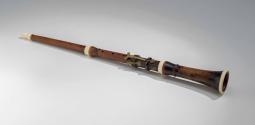Oboe
Date1750-1800
OriginEngland
MediumFruitwood turning with ivory ferrules and brass keys.
DimensionsOL; 23 1/4"; Diam of bell; 2 1/4"
Credit LineGift of Miss Lotta Van Buren
Object number1937-286
DescriptionTapering cylindrical tube, dark stained, made in three sections, each section joined by socket and tenon; bottom section flares outward to bell-shape at end; ivory ferrules between each section and at end of bell; ivory mouthpiece; central section contains three raised, turned bands; three fingerholes and two brass keys with round hole covers; another hole passes all the way through the bell section.Label TextOboes (or hautboys) were commonly played by men in formal concerts and military bands. Colonial Williamsburg archaeologists recovered a fragment of an oboe, pictured here, in a streambed behind the site of the Anthony Hay Shop in Williamsburg. The French horn and oboe often accompanied violins and other ensemble instruments in musical performances, balls, and even public funeral processions. Besides appearing in concerts and theater productions, oboes and horns were played in British and colonial American military bands. The latter were fairly standardized by the early 1760s to include 4 hautboys or clarinets, 2 bassoons, 2 trumpets, and 2 horns.
Inscribednone
MarkingsNone found
ProvenanceGift of Miss Lotta Van Buren
Exhibition(s)
1765-1785
ca. 1800
ca. 1808
1785-1806
1809-1817
1788-1821
ca. 1760
1816
ca. 1765 case; ca. 1740 movement
1809-1814 (movement); ca. 1825 (case)
1740-1770
ca. 1810
















